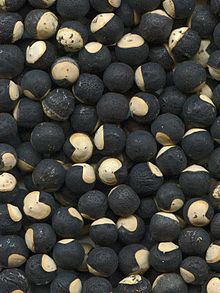Balloon vine
| Balloon vine | ||||||||||||
|---|---|---|---|---|---|---|---|---|---|---|---|---|

Balloon vine ( Cardiospermum halicacabum ) |
||||||||||||
| Systematics | ||||||||||||
|
||||||||||||
| Scientific name | ||||||||||||
| Cardiospermum halicacabum | ||||||||||||
| L. |
The plant Balloon vine ( Cardiospermum halicacabum ), even heart Same , belongs to the family of the soap tree plants (Sapindaceae). It is native to tropical and subtropical Africa, America, the Indian subcontinent and Malacca .
description
Vegetative characteristics
The balloon vine is a strongly overgrown, annual , rarely perennial herbaceous climbing plant that can even become lignified at the base. It can bloom at a height of around 25 cm, but usually grows much higher up to 3.5 meters. The slender, grooved stems are hairy bald to sparsely downy.
The 5 to 6 cm long, triangular leaves are distributed on the stem and divided into a petiole and a pinnate leaf blade. The petiole is (0.5 to) 1.5 to 3.5 cm long and the rachis is 0.4 to 2 cm long. The opposite leaflets are 1 to 2 cm long and the terminal leaflets are 4 to 6 cm long. The leaf margins are serrated. The stipules are reduced to tiny, early-falling scales.
Generative characteristics
On the side of a 5 to 9 cm long, sparsely downy hairy inflorescence stem, there are two 1 mm long bracts, two circularly rolled tendrils and three to seven flowers in a zymous inflorescence .
The functionally unisexual flowers are zygomorphic and fourfold double perianth (perianth). Of the four free, concave, durable sepals , the outer two are circular, 2 mm long and ciliate, while the inner two are elongated-ovate, 3 to 4 mm long and glabrous. The four white to yellowish petals are obovate and about 3 mm long, the upper two are each adorned with a woolly scale and the lower two have large, leaf-shaped scales and two glands. In the male flowers there are two circles with four free stamens each and rudimentary pistils. The compressed stamens are hairy and about 2 mm long and the anthers are about 0.5 mm long. In the female flowers are obovate, 2 to 3 mm long and hairy, insulated draft tube ovary with a short fluffy hairy stylus, which ends in a three-part scar and eight staminodes present.
The conspicuous, membranous, almost spherical or broad pear-shaped capsule fruits have a diameter of 3 to 5 cm, initially fluffy hairy, light green "balloons" brown when ripe. There is only one seed in each of the three fruit chambers. A noticeable feature of the individual seeds is a large, light heart-shaped spot on the otherwise almost black seed. The kidney-shaped seeds have a diameter of about 6 mm and a white heart-shaped aril about 5 mm wide at their base .
distribution
The balloon vine comes from the tropics and subtropics, but is now also grown in southern Germany.
Systematics
The scientific name Cardiospermum halicacabum was 1753 Carl Linnaeus in Species Plantarum , 1, pp 366-367 first published . The generic name Cardiospermum , translated into German as "heart seeds", was due to its large, black seeds, whose white mark is reminiscent of a stylized heart. The specific epithet halicacabum comes from the Greek word for salt barrel and refers to the inflated fruits, after which the common German name balloon vine is derived.
There are at least two varieties:
- Cardiospermum halicacabum L. var. Halicacabum
- Cardiospermum halicacabum var. Microcarpum (Kunth) Blume
ingredients
Triterpene saponins, halicaric acid, catechin tannins, terpenes, phytosterols, flavonoids, quebrachitol
use
The balloon vine is mainly used in homeopathy to treat eczematic skin. For this purpose, a mother tincture is made from the flowering parts of the plant. This is also processed into creams and ointments.
The green parts of the plant are eaten as vegetables. The underground plant parts and seeds are used medicinally.
The balloon vine is used as an annual ornamental plant.
swell
- Priscilla Abdulla: Cardiospermum halicacabum in the Flora of Pakistan : Online. (Section Description and Use)
- AW Exell: Sapindaceae in the Flora Zambesiaca , Volume 2, 1966: Cardiospermum halicacabum - Online. (Section description)
Individual evidence
- ↑ Cardiospermum halicacabum in the Germplasm Resources Information Network (GRIN), USDA , ARS , National Genetic Resources Program. National Germplasm Resources Laboratory, Beltsville, Maryland.
- ↑ a b Heike Käser: Natural cosmetic raw materials . Freya, Linz 2010



